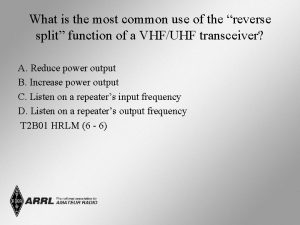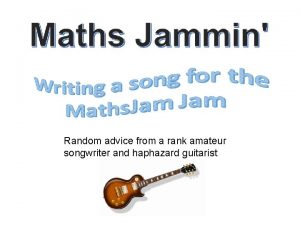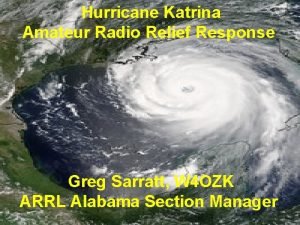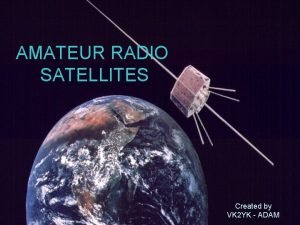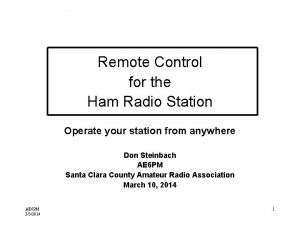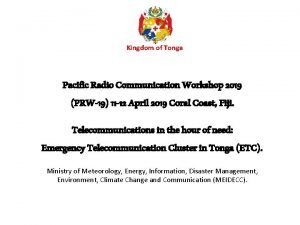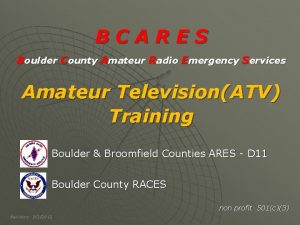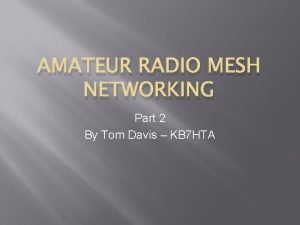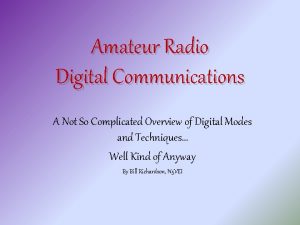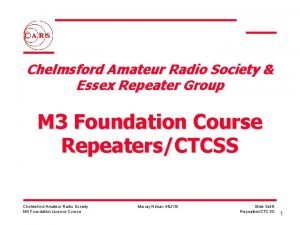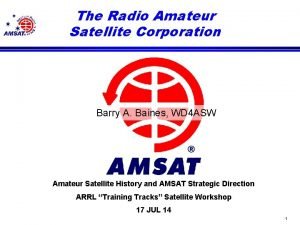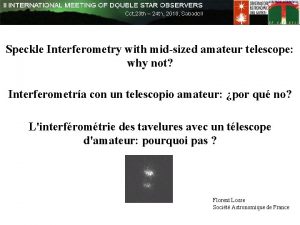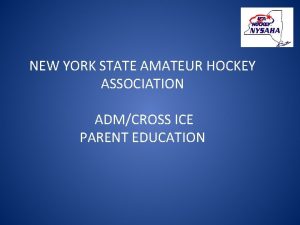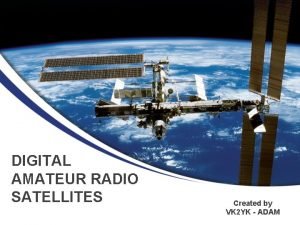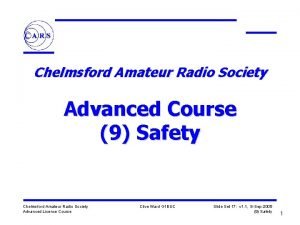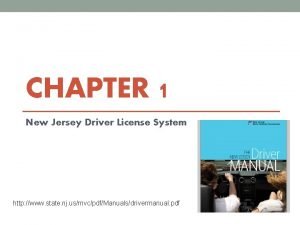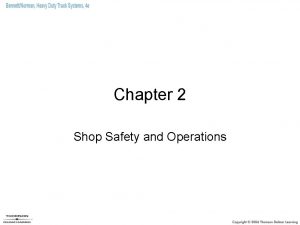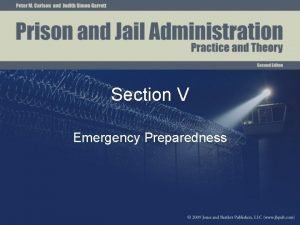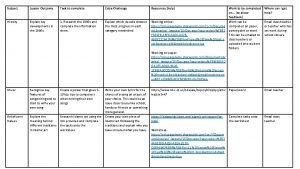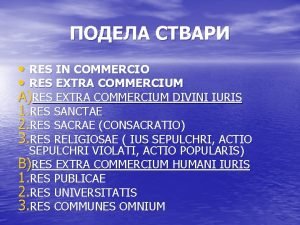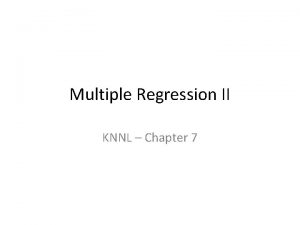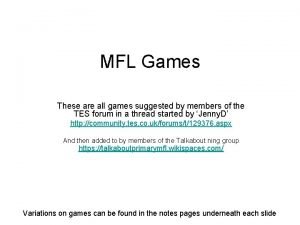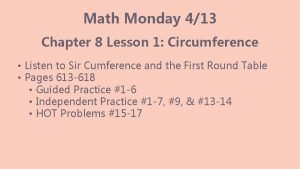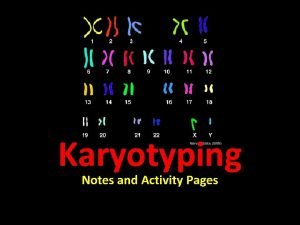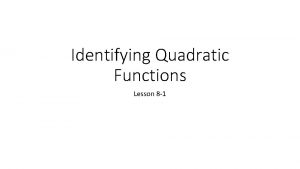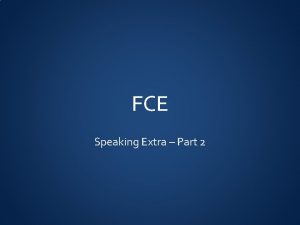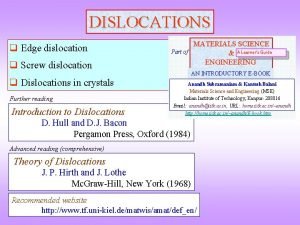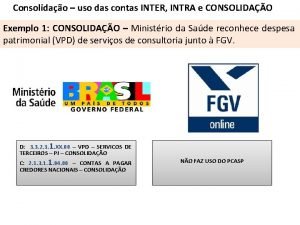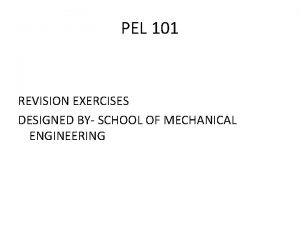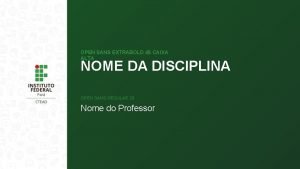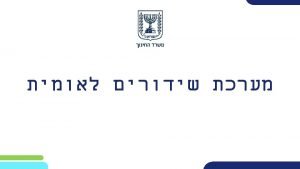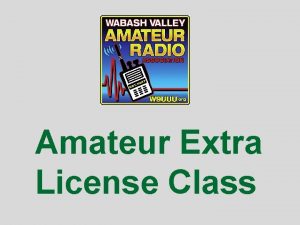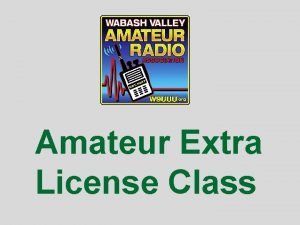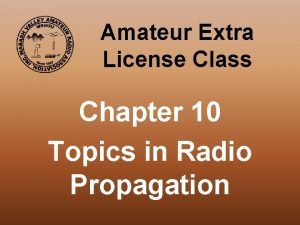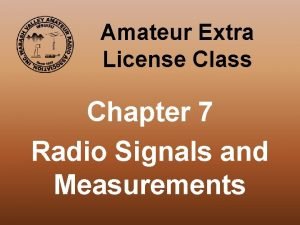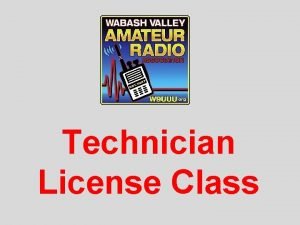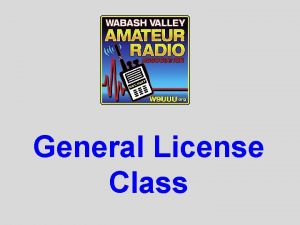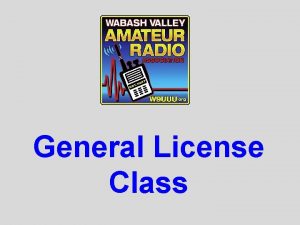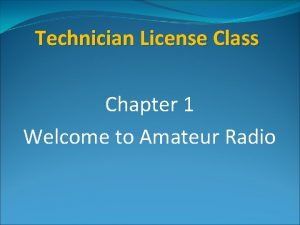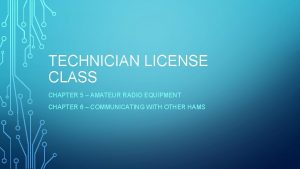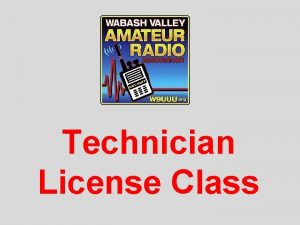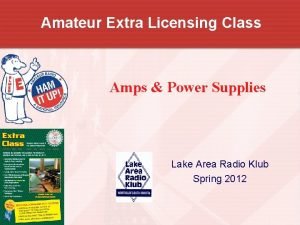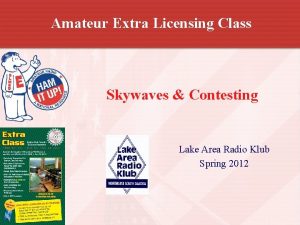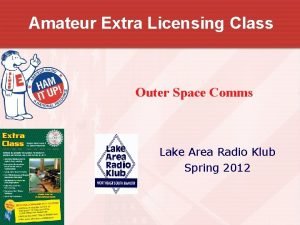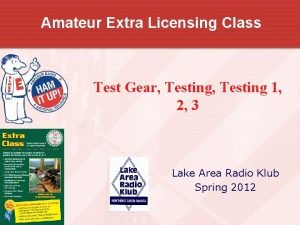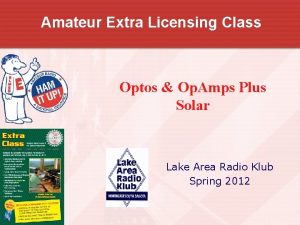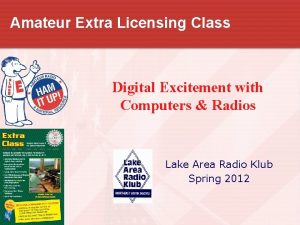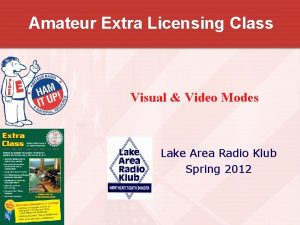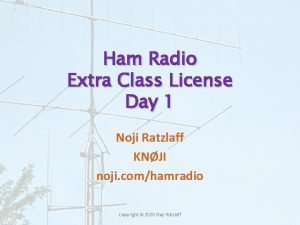Amateur Extra License Class Chapter 2 Operating Practices












































































- Slides: 76

Amateur Extra License Class Chapter 2 Operating Practices

General Operating • Extra Class HF Frequencies • • 80 m: 3. 500 MHz to 3. 525 MHz 75 m: 3. 600 MHz to 3. 700 MHz (& 3. 700 to 3. 800 Adv. ) 40 m: 7. 000 MHz to 7. 025 MHz 40 m: 7. 125 MHz to 7. 175 MHz (shared with Advanced) 20 m: 14. 000 MHz to 14. 025 MHz 20 m: 14. 150 MHz to 14. 175 MHz (& 14. 175 to 14. 225 Adv. ) 15 m: 21. 000 MHz to 21. 025 MHz 15 m: 21. 200 MHz to 21. 225 MHz (& 21. 225 to 21. 275 Adv. ) • Most DX operations in lower-end of the band. • Extra class portions of the bands are less crowded.

General Operation • Frequency Selection • Be aware of the band edges! • Refer to your band plan! Don’t think you know! Carrier Frequency Lower Side band Carrier Frequency -2. 8 KHz Upper Side band Carrier - 300 Hz Carrier +300 Hz Carrier Frequency +2. 8 KHz

General Operating • Frequency Selection (cont’d) • ITU Regions 1, 2, & 3 allocations (especially 40 m) • Band Plans • Alternate bands/frequencies. • Be flexible. • The latest thing: Remote operating >> Control operator using Internet to access transmitter/antenna in a better operating area • No call sign mod needed if both are in CONUS.

General Operating • DX’ing • Why DX? • DX windows • 160 m: 1. 830 MHz to 1. 835 MHz • 75 m: 3. 795 MHz to 3. 800 MHz • • http: //www. spaceweather. com/ http: //www. voacap. com http: //www. eham. net/ http: //ac 6 v. com/frequencies. htm SSN, K index, A index, etc. Worldwide band conditions Spotting Frequencies

General Operating • DX’ing • DX operating techniques • • Listen before you transmit! “You can’t work ‘em if you can’t hear ‘em!” Use your full call once or twice. Use standard (ICAO) phonetics (please). • Pileup management • Simplex: the norm • By-the-numbers: “CQ Florida” or “CQ the 1 calling area” • Split: Called station listening at higher freq than calling

General Operating • DX’ing • Split operation. • DX station may be on a frequency not available to some answering stations. • 40 m. • Separates calling stations from DX station. • Calling stations can hear DX station without interference. • Spreads out pile-up. • Fewer calling stations on each frequency reduces interference & DX station can more efficiently pick out a station to answer.

General Operating • DX’ing • Propagation • • • Propagation forecasting software. Voacap. com Propagation bulletins Beacons. Ncdfx. org, reversebeacon. net Telnet/Packet spotting networks. Move to lower frequency band as DX stations get weaker.

General Operating • QSL Cards • “The final courtesy of a QSO” • Can use Bureaus or Direct Mail • Bureau QSL managers process contact confirmations between U. S. and non-U. S. stations. • QSL Managers: Handle the receiving and sending of confirmation cards for a DX station • LOTW and QSLcc not really QSL Cards

General Operating • Contesting • Why contest? § 97. 1(c) -- Expansion of the existing reservoir within the amateur radio service of trained operators…. • Categories (single-op, multi-multi, etc. ). • Spotting networks, CWSkimmer, e. Ham. net. • “Self-spotting” generally prohibited. • Exchange. “ 59 Virginia”, “ 5908”, “ 59 number 52” • Multipliers, e. g. , specially designated stations

General Operating • Contesting • Operating Methods. • Search & Pounce. • “Running” a frequency. • Some contests restricted by band and/or mode. • By agreement, no contesting on 60, 30, 17, or 12 meters.

General Operating • Contesting – VHF & UHF • No repeater contacts. • Avoid recognized calling frequencies. • VHF/UHF contest activity normally found in weak signal portion of each band near calling frequency.

General Operating • Contesting • Submitting logs. • Paper logs. • Original method. • Generally discouraged. • May be prohibited for large logs. • Electronic logs. • Cabrillo format. wwrof. org/cabrillo • E-mail or website applet. • Do NOT have to submit log to participate.

General Operating • Contesting • Finding contests. • WA 7 BNM website. • http: //hornucopia. com/contestcal • ARRL website. • http: //www. arrl. org/contest-calendar • CQ Magazine website. • http: //www. cq-amateur-radio. com • National Contest Journal (NCJ) website. • http: //www. ncjweb. com/contests. php

E 2 C 08 – Which of the following contacts may be confirmed through the U. S. QSL Bureau system? A. Special event contacts between stations in the U. S. B. Contacts between a U. S. station and a non. U. S. station C. Repeater contacts between U. S. club members D. Contacts using tactical call signs

E 2 C 05 -- What is the function of a DX QSL Manager? A. To allocate frequencies for DXpeditions B. To handle the receiving and sending of confirmation cards for a DX station C. To run a net to allow many stations to contact a rare DX station D. To relay calls to and from a DX station

E 2 C 06 -- During a VHF/UHF contest, in which band segment would you expect to find the highest level of activity? A. At the top of each band, usually in a segment reserved for contests B. In the middle of each band, usually on the national calling frequency C. In the weak signal segment of the band, with most of the activity near the calling frequency D. In the middle of the band, usually 25 k. Hz above the national calling frequency

E 2 C 10 -- Why might a DX station state that they are listening on another frequency? A. Because the DX station may be transmitting on a frequency that is prohibited to some responding stations B. To separate the calling stations from the DX station C. To improve operating efficiency by reducing interference D. All of these choices are correct

E 2 C 11 -- How should you generally identify your station when attempting to contact a DX station during a contest or in a pile up? A. Send your full call sign once or twice B. Send only the last two letters of your call sign until you make contact C. Send your full call sign and grid square D. Send the call sign of the DX station three times, the words “this is”, then your call sign three times

E 2 C 12 -- What might help to restore contact when DX signals become too weak to copy across an entire HF band a few hours after sunset? A. Switch to a higher frequency HF band B. Switch to a lower frequency HF band C. Wait 90 minutes or so for the signal degradation to pass D. Wait 24 hours before attempting another communication on the band

E 2 C 03 -- From which of the following bands is amateur radio contesting generally excluded? A. 30 meters B. 6 meters C. 2 meters D. 33 cm

E 2 C 01 -- Which of the following is true about contest operating? A. Operators are permitted to make contacts even if they do not submit a log B. Interference to other amateurs is unavoidable and therefore acceptable C. It is mandatory to transmit the call sign of the station being worked as part of every transmission to that station D. Every contest requires a signal report in the exchange

E 2 C 07 -- What is the Cabrillo format? A. A standard for submission of electronic contest logs B. A method of exchanging information during a contest QSO C. The most common set of contest rules D. The rules of order for meetings between contest sponsors

E 2 C 02 -- Which of the following best describes the term “self-spotting” in regards to contest operating? A. The generally prohibited practice of posting one’s own call sign and frequency on a spotting network B. The acceptable practice of manually posting the call signs of stations on a spotting network C. A manual technique for rapidly zero beating or tuning to a station’s frequency before calling that station D. An automatic method for rapidly zero beating or tuning to a station’s frequency before calling that station

E 2 C 13 -- What indicator is required to be used by U. S. -licensed operators when operating a station via remote control where the transmitter is located in the U. S. ? A. / followed by the USPS two letter abbreviation for the state in which the remote station is located B. /R# where # is the district of the remote station C. The ARRL section of the remote station D. No additional indicator is required

Digital Mode Operating • Packet Radio • AX. 25 protocol • • ASCII. Block of data – typically 256 bytes. Add header, & checksum. Receiving station responds with ACK or request for repeat.

Digital Mode Operating • Packet Radio • Terminal Node Controller (TNC) • Mostly VHF or UHF • 1200 baud AFSK FM (2 m)

Digital Mode Operating • Packet Radio • Digipeater. • Satellite. • PACSAT. • Low Earth Orbit (LEO) satellites. • Store & forward. ISS example. • DX packet cluster.

Digital Mode Operating • Automatic Packet Reporting System (APRS)

Digital Mode Operating • Automatic Packet Reporting System (APRS) • Developed by Bob Bruniga, WB 4 APR. • Standard packet transmission. • AX. 25 protocol. • Latitude/Longitude and other information • Unnumbered information (UI) frames. • Typical frequency. • 144. 390 MHz (North America)

Digital Mode Operating • Automatic Packet Reporting System (APRS) • Applications. • Position reporting. • Uses GPS data to transmit latitude & longitude of station. • Severe weather spotting. • Public service events. • Balloons carrying amateur radio transmitters. • Weather data gathering. • Messaging.

Digital Mode Operating • Automatic Packet Reporting System (APRS) • Full-featured station. • • 2 m FM transceiver. TNC. Computer. GPS.

Digital Mode Operating • Automatic Packet Reporting System (APRS) • Stand-alone tracker. • 2 m FM transmitter. • TNC. • GPS.

Digital Mode Operating • Automatic Packet Reporting System (APRS) • http: //www. aprs. org • http: //aprsworld. net • http: //www. findu. com

E 2 D 04 -- What is the purpose of digital storeand-forward functions on an Amateur Radio satellite? A. To upload operational software for the transponder B. To delay download of telemetry between satellites C. To store digital messages in the satellite for later download by other stations D. To relay messages between satellites

E 2 D 05 -- Which of the following techniques is normally used by low Earth orbiting digital satellites to relay messages around the world? A. Digipeating B. Store-and-forward C. Multi-satellite relaying D. Node hopping

E 2 D 07 – What digital protocol is used by APRS? A. PACTOR B. 802. 11 C. AX. 25 D. AMTOR

E 2 D 08 -- What type of packet frames is used to transmit APRS beacon data? A. Unnumbered Information B. Disconnect C. Acknowledgement D. Connect

E 2 D 11 -- Which of the following data are used by the APRS network to communicate your location? A. Polar coordinates B. Time and frequency C. Radio direction finding LOPs D. Latitude and longitude

E 2 A 14 -- What technology is used to track, in real time, balloons carrying amateur radio transmitters? A. Radar B. Bandwidth compressed LORAN C. APRS D. Doppler shift of beacon signals

E 2 D 10 -- How can an APRS station be used to help support a public service communications activity? A. An APRS station with an emergency medical technician can automatically transmit medical data to the nearest hospital B. APRS stations with General Personnel Scanners can automatically relay the participant numbers and time as they pass the check points C. An APRS station with a GPS unit can automatically transmit information to show a mobile station's position during the event D. All of these choices are correct

Amateur Satellites

Amateur Satellites • Understanding Satellite Orbits • Johannes Kepler (1571– 1630). • Mathematically described orbits of planets. • Same laws apply to artificial satellites orbiting the Earth.

Amateur Satellites • Understanding Satellite Orbits • Kepler’s 1 st Law. • All planetary orbits are elliptical with the Sun at one of the foci of the ellipse.

Amateur Satellites • Understanding Satellite Orbits • Kepler’s 2 nd Law. • A line joining a planet and the Sun sweeps out equal areas during equal intervals of time.

Amateur Satellites • Understanding Satellite Orbits • Kepler’s 3 rd Law. • The square of the orbital period of a planet is directly proportional to the cube of the semi-major axis of its orbit. • In plain English – The farther a planet is from the Sun, the longer it takes to complete one orbit around the Sun. • Low Earth Orbit (LEO) satellites typically have orbital periods of about 90 minutes. • Satellites at about 22, 387 miles above the Earth have orbital periods of 24 hours and are called geosynchronous or geostationary satellites. • Orbital period = The time it takes for a satellite to complete one revolution around the Earth

Amateur Satellites • Understanding Satellite Orbits • Keplerian elements. • Sets of numbers that describe a satellites orbit. • If you know the Keplerian elements for a satellite, you can determine its position at any given time. • Software programs use Keplerian elements to plot the current positions of satellites. • Sat. Scape • Orbitron • Sat. PC 32 • W 1 AW Keplerian elements broadcast, Tues & Fri, 1830 hrs

Amateur Satellites • Keplerian elements example: Satellite: FO-29 Catalog number: 24278 Epoch time: 13254. 74297939 Element set: 197 Inclination: 098. 5457 deg RA of node: 301. 6933 deg Eccentricity: 0. 0349499 Arg of perigee: 299. 9056 deg Mean anomaly: 170. 2427 deg Mean motion: 13. 53005152 rev/day Decay rate: 1. 0 e-07 rev/day^2 Epoch rev: 84301 Checksum: 333

Amateur Satellites • Orbital Mechanics • Inclination. • The angle of an orbit with respect to the Equator. • An orbit with an inclination of 0° is always directly over the Equator. • An orbit with an inclination of 90° will pass directly over both the North Pole and the South Pole, i. e. , Polar orbit. • Apogee • The point in an orbit where the satellite is farthest from the Earth. • Perigee • The point in an orbit where the satellite is closest to the Earth.

Amateur Satellites • Orbital Mechanics • Node. • A point in an orbit where the satellite crosses the Equator. • Ascending node. • The point in an orbit where the satellite crosses the Equator from south to north. • Descending node. • The point in an orbit where the satellite crosses the Equator from north to south.

Amateur Satellites • Orbital Mechanics • Definitions. • Ascending pass. • The pass of a satellite over a location while traveling from south to north. • Descending pass. • The pass of a satellite over a location while traveling from north to south.

Amateur Satellites • Orbital Mechanics

Amateur Satellites • Spin Modulation • Satellites are often stabilized by having them spin about their axis like a gyroscope. • The spin causes amplitude changes and polarization changes of the received signal, which sounds like fading. • Effects of spin modulation are minimized by using circular polarization.

Amateur Satellites • Faraday Rotation • The polarization of a radio wave is shifted as it passes through the ionosphere. • The polarization appears to be continuously rotating as seen by the receiving station. • Effects of Faraday rotation are minimized by using circular polarization. • RHCP, LHCP

Amateur Satellites • Satellite Operation • There are 3 main types of satellite systems. • Repeaters. • Transponders. • Digital store & forward.

Amateur Satellites • Satellite Operation • Repeaters. • FM voice repeaters on satellites function exactly like repeaters on the surface of the Earth. • Typically satellite repeaters are cross-band repeaters. • Repeater input & output frequencies are on different bands. • Some satellite repeaters can be accessed using a dualband held radio with a handheld 2 m/70 cm beam. • Repeaters are installed on the International Space Station (ISS), AO-27, & other satellites. • https: //www. amsat. org/

Amateur Satellites • Satellite Operation • Transponders. • A linear translator that receives a range of frequencies in one band & shifts it to a range of frequencies in a different band. • Many stations can communicate through the satellite simultaneously using different modes. • Any type of signal can be sent using a transponder. • Since all users share the available power on that transponder, continuous-duty modes such as RTTY or FM are not normally used.

Amateur Satellites • Satellite Operation • Digital store & forward. • Satellite-based file servers that can store messages for retrieval by another station at a different location in the orbit. • Uses packet radio. • AO-16 or PACSAT.

Amateur Satellites • Satellite Operating Frequencies • Satellite mode denotes uplink & downlink frequencies. • Pair of letters. • 1 st letter = uplink frequency. • 2 nd letter = downlink frequency. • Mode U/V means 70 cm uplink & 2 m downlink.

Amateur Satellites • Satellite Operating Frequencies • Mode Designators Designator Band H 15 m (21. 0 MHz to 21. 45 MHz) 10 m (28. 0 MHz to 29. 7 MHz) V 2 m (144 MHz to 146 MHz) U 70 cm (435 MHz to 438 MHz) L 23 cm (1. 26 GHz to 1. 2 GHz) S 13 cm (2. 4 GHz to 2. 45 GHz) C 5 cm (5. 8 GHz) X 3 cm (10. 45 GHz) K 1. 2 cm (24 GHz)

Amateur Satellites • Doppler Shift • Because satellite is moving at high speed, apparent frequency changes as satellite moves past earth station. • Apparent frequency is higher than actual frequency as satellite approaches earth station. • Apparent frequency is lower than actual frequency as satellite moves away from earth station. • Apparent frequency = actual frequency when earth station is 90° from satellite path.

Amateur Satellites • Doppler Shift

E 2 A 03 -- What is the orbital period of an Earth satellite? A. The point of maximum height of a satellite's orbit B. The point of minimum height of a satellite's orbit C. The time it takes for a satellite to complete one revolution around the Earth D. The time it takes for a satellite to travel from perigee to apogee

E 2 A 13 -- What type of satellite appears to stay in one position in the sky? A. HEO B. Geostationary C. Geomagnetic D. LEO

E 2 A 12 -- What is one way to predict the location of a satellite at a given time? A. By means of the Doppler data for the specified satellite B. By subtracting the mean anomaly from the orbital inclination C. By adding the mean anomaly to the orbital inclination D. By calculations using the Keplerian elements for the specified satellite

E 2 A 01 -- What is the direction of an ascending pass for an amateur satellite? A. From west to east B. From east to west C. From south to north D. From north to south

E 2 A 02 -- What is the direction of a descending pass for an amateur satellite? A. From north to south B. From west to east C. From east to west D. From south to north

E 2 A 10 -- Why may the received signal from an amateur satellite exhibit a rapidly repeating fading effect? A. Because the satellite is spinning B. Because of ionospheric absorption C. Because of the satellite's low orbital altitude D. Because of the Doppler Effect

E 2 A 11 -- What type of antenna can be used to minimize the effects of spin modulation and Faraday rotation? A. A linearly polarized antenna B. A circularly polarized antenna C. An isotropic antenna D. A log-periodic dipole array

E 2 A 07 -- Which of the following types of signals can be relayed through a linear transponder? A. FM and CW B. SSB and SSTV C. PSK and Packet D. All of these choices are correct

E 2 A 08 -- Why should effective radiated power to a satellite which uses a linear transponder be limited? A. To prevent creating errors in the satellite telemetry B. To avoid reducing the downlink power to all other users C. To prevent the satellite from emitting out of band signals D. To avoid interfering with terrestrial QSOs

E 2 A 04 -- What is meant by the term mode as applied to an amateur radio satellite? A. The type of signals that can be relayed through the satellite B. The satellite's uplink and downlink frequency bands C. The satellite's orientation with respect to the Earth D. Whether the satellite is in a polar or equatorial orbit

E 2 A 05 -- What do the letters in a satellite's mode designator specify? A. Power limits for uplink and downlink transmissions B. The location of the ground control station C. The polarization of uplink and downlink signals D. The uplink and downlink frequency ranges

E 2 A 06 -- On what band would a satellite receive signals if it were operating in mode U/V? A. 435 -438 MHz B. 144 -146 MHz C. 50. 0 -50. 2 MHz D. 29. 5 to 29. 7 MHz

E 2 A 09 -- What do the terms L band S band specify with regard to satellite communications? A. The 23 centimeter and 13 centimeter bands B. The 2 meter and 70 centimeter bands C. FM and Digital Store-and-Forward systems D. Which sideband to use

Questions?
 Where may ssb phone be used in amateur bands above 50 mhz?
Where may ssb phone be used in amateur bands above 50 mhz? Random amateur
Random amateur Club lust production
Club lust production Katrina amateur
Katrina amateur Vk com amateur
Vk com amateur Revenge porn amateur
Revenge porn amateur Remote ham radio control
Remote ham radio control Tonga ham radio
Tonga ham radio Bcares
Bcares Linkcalc ubnt
Linkcalc ubnt Amateur radio digital communications
Amateur radio digital communications Chelmsford amateur radio society
Chelmsford amateur radio society Amateur sp
Amateur sp Amateur sdx
Amateur sdx Japanese amateur jc
Japanese amateur jc Student teacher amateur
Student teacher amateur Amateur insemination
Amateur insemination Telescopio amateur
Telescopio amateur New york state amateur hockey association
New york state amateur hockey association Vk amateur
Vk amateur Chelmsford amateur radio society
Chelmsford amateur radio society Chelmsford amateur radio society
Chelmsford amateur radio society Bbhn
Bbhn Driver license class
Driver license class Class c license
Class c license Extra credit ch 3
Extra credit ch 3 Extra credit chapter 15
Extra credit chapter 15 If a student driver commits a traffic violation
If a student driver commits a traffic violation Chapter 1 the new jersey driver license system answers
Chapter 1 the new jersey driver license system answers Chapter 1 the new jersey driver license system answers
Chapter 1 the new jersey driver license system answers Chapter 36 emergency preparedness and protective practices
Chapter 36 emergency preparedness and protective practices Chapter 2 safety practices
Chapter 2 safety practices Analyzing transactions
Analyzing transactions Chapter 2 safety practices
Chapter 2 safety practices Chapter 36 emergency preparedness and protective practices
Chapter 36 emergency preparedness and protective practices Radazin extra
Radazin extra Two types of relative clauses
Two types of relative clauses Res extra commercium
Res extra commercium Uyan nomo salbe
Uyan nomo salbe Res in commercio
Res in commercio Type of clasp in rpd
Type of clasp in rpd Remote broadcast solutions
Remote broadcast solutions Extra information clauses
Extra information clauses Separates bill
Separates bill Res extra patrimonium
Res extra patrimonium Extra sum of squares multiple regression
Extra sum of squares multiple regression 3 hotel guest riddle
3 hotel guest riddle Atantot extra
Atantot extra Lesson 1 circumference page 619 answers
Lesson 1 circumference page 619 answers Luxation extra coracoidienne
Luxation extra coracoidienne Xyy syndrome pictures
Xyy syndrome pictures Operazioni triangolari extra ue
Operazioni triangolari extra ue Definition of schizophrenia
Definition of schizophrenia Lesson 8 homework practice quadratic functions
Lesson 8 homework practice quadratic functions Xyy chromosomes
Xyy chromosomes Extra y chromosome
Extra y chromosome Slidetodoc.com
Slidetodoc.com Extra lesson antroposofia
Extra lesson antroposofia Trabajo extraclase
Trabajo extraclase Edge and screw dislocation
Edge and screw dislocation Inter intra extra
Inter intra extra Extaramove
Extaramove Widening of gauge on curves
Widening of gauge on curves Praescriptio longissimi temporis
Praescriptio longissimi temporis Ira pré renal renal e pós renal
Ira pré renal renal e pós renal Extracoronal direct retainers
Extracoronal direct retainers The eight slots on pam's extra large toaster
The eight slots on pam's extra large toaster Open sans extrabold
Open sans extrabold Spotted sandpiper
Spotted sandpiper The extra dopamine released during drug use can
The extra dopamine released during drug use can Medicover program zdrowie plus
Medicover program zdrowie plus Extra markup html
Extra markup html Flammantia moenia mundi
Flammantia moenia mundi Count that day lost
Count that day lost Coleção extra-axial benigna da infância
Coleção extra-axial benigna da infância Montserrat extra
Montserrat extra Jeanne nollman
Jeanne nollman
